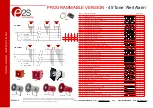
12
Instruction Booklet
IB022003EN
Effective April 2018
Revision #3
Instructions for installation, operation, and
maintenance of Type MVS-ND, metal-enclosed
switchgear assemblies: 4.76 kV or 15.0 kV class
EATON
www.eaton.com
After the live parts, insulators, and drive rod links have been dusted
and wiped clean, take “MEGGER” readings again between the
live parts and between phases . Keep a record of these readings
for future reference in determining when trends occur that would
indicate a lowering of the insulation resistance .
Periodic high potential tests are not required after initial start-up
and are recommended only after repair of high voltage live parts or
insulation, or when the trend of “MEGGER” readings indicates it to
be advisable . This field test should be made before the main cables
are connected and should not exceed the values in Table 6 .
Table 6. Field Dielectric Test Values.
kV Class
Test Voltage, 60 Hz AC,
Applied for 1 Minute
5
14.25
15
27
The intent of the cleaning procedure is to remove as much dirt,
dust, and other foreign material as possible from the insulation
with minimum exposure to any solvents . The recommended
cleaning procedure is to use a lint-free cloth . In most cases this
will be sufficient .
For accumulations that cannot be removed by the above procedure,
a lint-free cloth, slightly dampened with water, can be used . Allow
the apparatus to dry for at least four hours at room temperature
before energizing or testing . If a lint-free, water dampened cloth
does not produce satisfactory results, use a lint-free cloth
dampened with isopropyl alcohol . Dry the same as when using
a water-dampened cloth .
CAUTION
ISOPROPYL ALCOHOL IS FLAMMABLE. PROVIDE ADEQUATE VENTILATION
AND KEEP AWAY FROM FLAMES AND OTHER IGNITION SOURCES.
CONSULT YOUR SAFETY DEPARTMENT BEFORE USING.
Fuse replacement
WARNING
FAILURE TO COMPLETELY DISCONNECT THE MVS-ND SWITCHGEAR
ASSEMBLY FROM ALL POWER SOURCES PRIOR TO INSPECTION MAY
RESULT IN SEVERE INJURY OR DEATH. THE SWITCHGEAR ASSEMBLY
MUST BE COMPLETELY DISCONNECTED FROM ALL POWER SOURCES
AND GROUNDED BEFORE PERFORMING ANY INSPECTION.
WARNING
WHEN ACCESSING FUSES, FAILURE TO ASSURE THAT THE FUSES ARE
DE-ENERGIZED MAY RESULT IN EQUIPMENT DAMAGE, BODILY INJURY,
OR DEATH. MAKE SURE THAT ALL POWER SOURCES ARE DE-ENERGIZED
BEFORE ATTEMPTING TO ACCESS THE FUSES.
Step 1: All devices that could energize the fuse should be opened,
padlocked, and tagged so that inadvertent closure cannot
create a hazard .
Step 2: The MVS-ND switch should be opened by rotating the
handle downward .
Step 3: Before opening the door, look through a window to visually
verify that all blades are disengaged from their break jaws .
Step 4: After opening the door, an appropriate medium voltage-
sensing device should be used to determine if voltage is
present .
Step 5: If no voltage is present, a suitable grounding device should
be attached to the fuse terminals to discharge any static
charge and assure that the fuse terminals remain at ground
potential .
Fuses are removed by removing the bolted fasteners located at
both ends of the fuse . Fuses are then free to be removed . When
fuses are re-installed, the fasteners should be retightened, referring
to MVS-ND switchgear bolt tightness for bus connections on Page
13 for torque values .
Lubrication
Lubrication should be done during routine maintenance . All excess
lubrication must be removed with a clean cloth to prevent any
accumulation of dust or dirt .
Avoid any lubrication on insulation . Care must be taken to prevent
any non-conductive lubricant from reaching any current carrying
contact surface . Use conductive grease (Eaton part number
7274A48H02) on moving and sliding contacts . Use mechanical
lubricating grease (Eaton part number 53701AI) on moving parts that
are not electrical contacts . See IB022004EN for the MVS-ND switch
lubrication requirements . For other components see the appropriate
instruction documents for those components, for their lubrication
requirements .






































